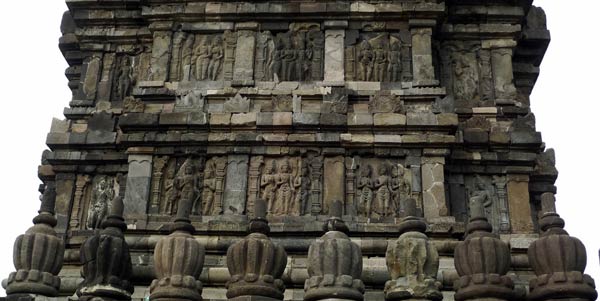Prambanan Temple Compounds, Yogyakarta
Candi Prambanan or Prambanan Temple Compounds, also known as Candi Rara Jonggrang is a well known ancient Hindu Temple in Java, Indonesia. This 9th century temple built by Trimurti as an expression that God is the Creator (Brahma), Preserver (Vishnu) and also the Destroyer (Shiva) is a UNESCO World Heritage Site.
Most travelers will gape at its magnificence as they approach the temple from the walkway as it loomed nearer. This is one structure to be noted with, being one of the the biggest Hindu Temple in Southeast Asia. It towers at 47 m high with a wide compound surrounding it inclusive with many temples arranged all around.

Entering to Prambanan Temple Compounds, Yogyakarta
Prambanan is the largest Hindu temple in ancient Java and this royal temple is probably built during the Hindu Sanjaya Dynasty. Historian suggest that this temple marks the return of the Hindu Sanjaya Dynasty to power in Central Java after almost a century of Buddhist Sailendra Dynasty domination. It also signifies the the focus from Mahayana Buddhism to Shivaist Hinduism.

Upclose with Prambanan, Yogyakarta
This temple is also known for the Rara Jonggrang legend, where it is said that Prince Bandung Bondowoso fell in love with Princess Rara Jonggrang, daughter of King Boko. The princess rejected his marriage proposal because he had killed her father but after his insistence, gave him an impossible condition – to build thousands of temples in one night. With help of supernatural beings, the prince manage to build 999 temples but the princess fearing his success, had the village maids to began pounding rice and set fire in east to fake the sunrise thus cheating the spiritual helpers to leave. The prince was furious about the trick and cursed Rara Jonggrang into a stone which she became the last and most beautiful of the thousand statues. According to the legend, this last unfinished thousand temple is the Sewu temple (means thousands) nearby to Prambanan and the Princess statue is in the north cell of the Shiva temple in Prambanan.
Where is it
Prambanan Temple compound is located 18 km east of Yogyakarta
in Central Java, Indonesia.
in Central Java, Indonesia.
Why visit
For the magnificence of one of the largest Hindu Temple in Southeast Asia and the rich legend behind these foreboding temples of ancient times.

Reliefs / carvings on Prambanan Temple, Yogyakarta
Most times is good for visiting Prambanan, whether it is the dry season (April – October) or wet season (November – March) of the two seasoned Indonesia.
Dry season will have a peak of tourists and also can be really hot while wet season will see rain later in the day so go early for your visit.

Inside Prambanan Temple Compounds, Yogyakarta
Best way to get here is first fly to Yogyakarta, and then use the Transjogja public bus to visit Prambanan. You can also hire a car from Yogyakarta to Prambanan and stop by various temples on the way.
Candi Sewu – just 10-15 minutes walk from the Prambanan temple, it is worth a visit as the temple ruins is eerily captivating and as a good respite from the crowds in Prambanan.
Candi Sambisari – a good stopover temple on the way to Prambanan, it had been buried underground for more hundred years before discovery in 1966. Reconstructed, it now stands as a testament to archeologists efforts to restore the glory of the past.
Borobudur Temple Compounds – A 9th century Buddhist temple is the largest Buddhist structure in the world and is an Indonesia UNESCO Heritage site. It consists of six square platforms with 2,672 relief panels and 504 Buddha status.
Yogyakarta - packed with all the intricacies of a good travel place with hidden treasures of bygone days, narrow alleys and main streets of delights, large array of delicious food to try, arts and cultures dotted everywhere and rich in history.

Prambanan Temple Compounds, Yogyakarta
Just like Borobudur, it is best to enjoy it at earliest hour possible to simply admire the grandeur in peace and quiet.
At night there might be performance of Hindu Ramayana in the temple, you may check with the place you stay for an arranged tour.

No comments:
Post a Comment